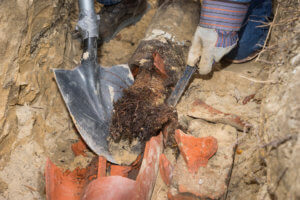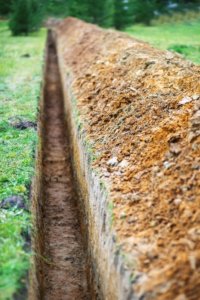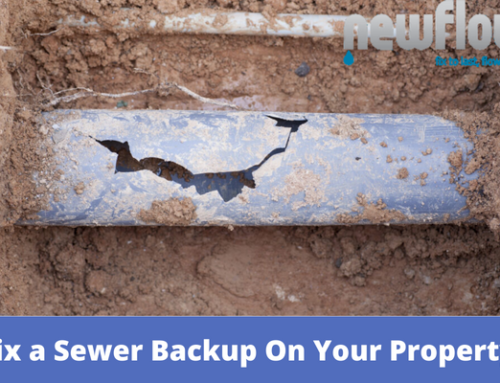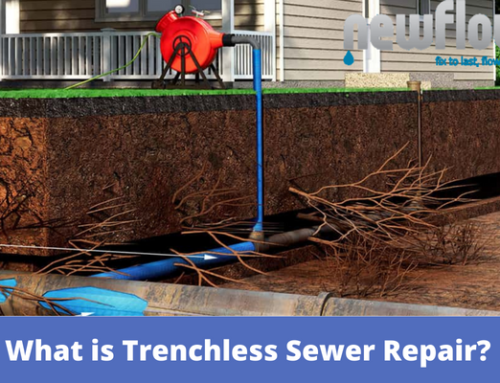Understanding Trenchless Sewer Repair: How it All Works
By New Flow Plumbing Inc.|Published On: December 17th, 2020|Categories: Residential Plumbing, Sewer Systems|
How Does Trenchless Sewer Repair Work?
What is trenchless sewer repair and how does it work? Trenchless technology has allowed modern plumbers and piping companies, to repair or replace sewer lines without tearing up your home. It’s a cost-effective, time-saving, non-invasive, and long-lasting solution to fixing your sewer lines.

How does trenchless sewer repair work?
Trenchless technology, compared to conventional trenching repair, does not involve digging in your home or property. New Flow Plumbing has mastered the craft of taking care of your problem and not leave you with a hefty clean-up cost. Trenchless technology is fast, only taking a few hours once the work begins. We can keep your home looking good while the work is being completed and you do not need to relocate.
Read more about: Signs and Symptoms of a Broken Sewer Line
What pipes can be repaired using trenchless technology?
- Pipes under homes, commercial buildings, or expensive landscaping
- Cracked pipes that are having trouble with invasive roots and debris
- Leaky pipes
- Corroded pipes
- Vertical stacks in multi-story buildings
- Lateral lines that connect residential homes or commercial buildings to the city sewer or septic tank
- Slightly misaligned pipes. (While pipe lining doesn’t realign the pipe, it will smooth out any rough edges that could cause debris to get stuck.)
There are two different methods of trenchless sewer repair, each of which depends on the integrity and location of pipe.

Sewer lines can be infested with tree roots and will need repair.
1. Pipe bursting
If a pipe is losing its structural integrity, we can use pipe bursting. It’s usually cheaper than pipe ling, running from $60 to $200 per foot. Pipe bursting can replace 600+ feet of pipe. It has some limitations that it make more ideal for straight runs of pipe and horizontal pipe. This is an environmentally-friendly process that involves no chemicals.

Conventional sewer repair involves digging long trenches. Trenchless technology avoids this.
Let’s breakdown the exact steps that pipe bursting takes.
- We inspect the pipe with a special CCTV sewer camera to assess the damage and look for blockages. The sewer line inspection is non-invasive, meaning it does not damage your property of pipes, and only takes 30 minutes to complete.
- The next step involves digging two small pits (around 4ft x 4ft) to access the damaged pipe.
- The new HDPE (high-density polyethylene) replacement pipe is then attached to a winch with a cone-shaped bursting head and pulled through the damaged pipe. As this happens, the damaged pipe is broken apart and the new pipe takes its place. The new HDPE pipe is hooked up to your plumbing system so that the connection is complete.
- Once the repair is complete, the two access points are filled.
- The final step is another sewer camera inspection to make sure everything is running properly.
Pipe bursting can also be used to replace a functioning pipe with a larger one to increase the flow rate. Pipe bursting is a permanent solution that lasts 50 to 100 years.
2. Pipe Lining
Also called structural pipe lining, or cured-in-place-pipe lining (CIPP), involves a special, epoxy-impregnated liner to create a new pipe directly inside your old one. CIPP is designed to last up to 50 years! Pipe lining usually costs $80 to $250 per foot. The price depends on a variety of factors, such as the condition of the pipe, ease of navigation, the amount of cleaning needed before the lining, and the accessibility of the pipe.
CIPP can be used on sewer pipes that have corroded over time, or have cracked and are now experiencing problems with invasive tree roots and soil. After lining, the roots and soil won’t be able to get back into the pipe.
Trenchless lining can be used on;
- Residential, commercial, and industrial sewer pipes
- Vertical vent stacks in kitchens, laundry rooms, etc.
- Lateral lines
- Building mains
- Branch lines
- Rainwater leaders
- Underground storm lines

Only certified and experienced plumbing technicians with the necessary special equipment should perform sewer pipe lining.
Here are the steps broken down.
- Your pipe is first inspected by a CCTV sewer camera.
- The pipe is then cleaned using hydro jetting. We make sure the pipe is back to its original diameter (or as close to it as possible).
- Next, we insert an epoxy-impregnated liner into the old pipe. Inside the liner is another layer called a bladder, which will inflate and press the epoxy against the pipe. After a few hours the epoxy cures and now you have a new pipe directly inside the old one.
- The next step involves reinstating any branches that were covered over during the pipe lining process. This is done robotically using special equipment.
- Lastly, we perform another CCTV inspection to ensure everything is completed and then fill in any pits or reinstall any fixtures we removed.
Note: The pipe’s diameter does become slightly smaller but it increases your new pipe’s flow capacity due to the slickness of the new material.
Sewer lining is not something that can be done in a few hours by one plumber. It takes 3-4 plumbing technicians, a half-day of preparation, an entire day for the installation, and then a few hours for the final inspection.
Only certified and experienced plumbing technicians with the necessary special equipment should perform sewer pipe lining. We at New Flow Plumbing can tackle anything your plumbing throws at us! Call us today and receive a quote.




